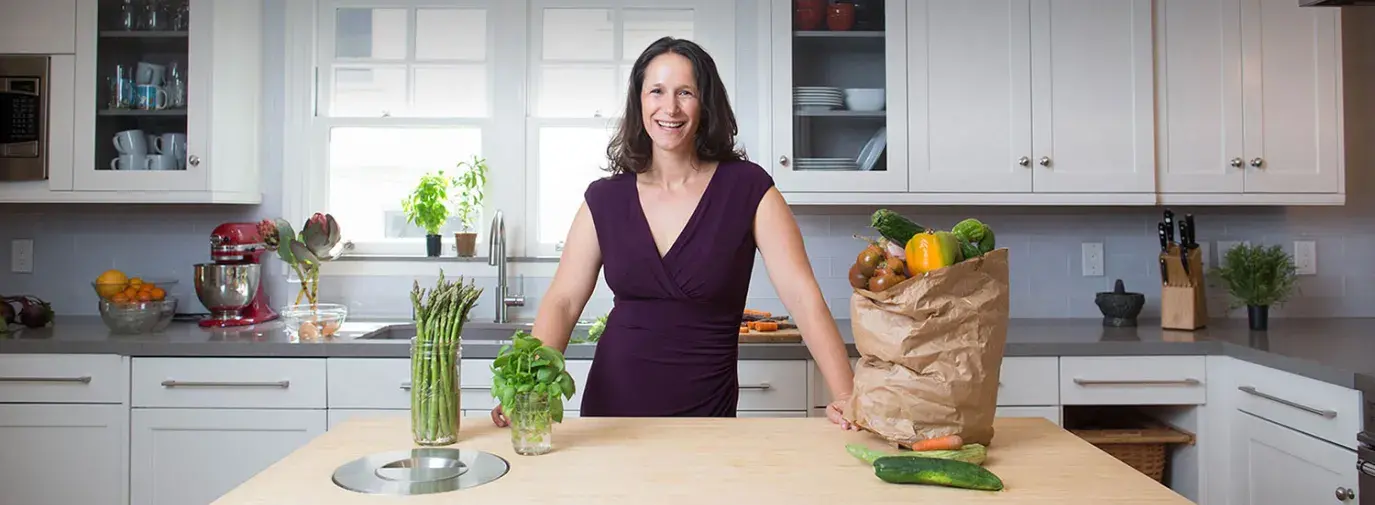
If you want to know the ins and outs of wasting less food, you don’t have to look much farther than Dana Gunders’ book, Waste-Free Kitchen Handbook (Chronicle Books, 2016). In it, Gunders examines how and why we throw away food in America — then provides step-by-step instructions on how to generate less food waste, from reorganizing your fridge to ensure older foods get eaten first, to fine-tuning meal-planning and shopping habits to salvaging wilted or hardened ingredients.
Gunders is senior scientist at the Natural Resources Defense Council (NRDC), with a B.S. and M.S. in Earth Systems from Stanford University. She leads NRDC’s work on reducing food waste across the country. Her work on food waste has been featured by CNN, NBC, NPR, the New York Times, and Last Week Tonight with John Oliver.
Green America’s Tracy Fernandez Rysavy talked with Gunders about why food waste is such a big problem in the US and how we can curb it.
Green America/Tracy Fernandez Rysavy: What got you started caring so much about food waste that you wrote a book about it?
Dana Gunders: I got into this topic working on a project [for the NRDC] with the fruit and vegetable industry in California on sustainable agriculture in general. There were several different topics, and one I was focused on was waste on farms, which really dealt more with used irrigation piping and that type of waste. But as I started researching, I saw staggering numbers on how much food was wasted.
We were trying to get farmers to use a little less water, fewer inputs, but 40 percent of the food they grow isn’t getting eaten, and that’s crazy!
 Photo courtesy of DanaGunders.com
Photo courtesy of DanaGunders.comThat discovery led to 2012 report I wrote [“Wasted: How America is Losing Up to 40 Percent of its Food from Farm to Fork to Landfill”]. The report was, to our surprise, a complete success with the media, and it plunged me into center of topic. I noticed how much it resonated with people. They would often tell me, “You’re right: I waste so much.”
Nobody wants to waste food, but it’s happening daily in our lives. Part of that is that people are missing certain amount of information [on how to waste less]. So I wrote the book to try to provide the inspiration and information people need in their own kitchens.
Green America/Tracy: Why is food waste such a big deal when it comes to the environment? How serious of an impact does wasting 40 percent of our food have?
Dana Gunders: It’s huge! A quarter of all the water in this country is growing food that never gets eaten. Then there’s the greenhouse gas effects of growing, transporting, cooling, cooking, and letting that food go to a landfill and rot — equivalent to 39 million cars’ worth annually. To say nothing of land, fertilizer, and pesticide use. To add to that, food is the number-one product going into landfills.
“The greenhouse-gas effects of growing, transporting, cooling, cooking, and letting that food go to landfill and rot [are] equivalent to 39-million cars’ worth annually.”
Green America/Tracy: Your book is an excellent resource, and if I could, I’d put a copy in the hands of everyone reading this interview. But given the space we have here, what are the top three or four things people should start doing to curb their food waste?
Dana Gunders: There are a few things that can be really easy, which is a great place to start. Freeze your food. A lot of people don’t think, “I have leftovers — I should freeze them.” But it’s perfectly okay to freeze small amounts of food to eat later: leftover rice, milk, bread, juice. Especially before you go away for the weekend or on vacation.
Another is understanding expiration dates. For most foods, those dates are not telling you to throw the food out. Expiration dates are not regulated, but most are really meant to indicate freshness rather than food safety. Just learning when your food goes bad for real and not blindly throwing food out on those dates is an easy thing to do.
Many of us will throw a frozen pizza in the oven because we’re tired, instead of making the meal we planned. We have to be realistic about those tendencies when we’re shopping, not aspirational. And on a regular night, “Fridge Fridays” or “StirFridays” or whatever, make a leftover concoction with whatever’s in your fridge.
Green America/Tracy: I’m truly bad at improvisational cooking. Terrible things happen in my kitchen when I try it.
Dana Gunders: In the book, I try to give a lot of “use-it-up” recipes that work with a variety of ingredients to empower people who are bad at improvisational cooking!
Green America/Tracy: Let’s go back to expiration dates. I’ve always assumed those dates indicate when the food starts to spoil, but you’re saying that’s not the case. I feel like that’s going to be a hard mindset to let go of.
Dana Gunders: You’re not alone. About 9 out of 10 people at least occasionally toss food prematurely due to expiration dates. It’s really important to understand that those dates are not meant to indicate when food goes bad. They indicate when a product is at its peak freshness and quality. Start with a product that’s really safe like yogurt or cheese, and try it the day after or two days after it expires. Don’t leave it in there for weeks. Try to add a few days, and just see what happens.
Green America/Tracy: So what are the biggest areas of food waste for us as individuals?
Dana Gunders: Going out to eat is a big one. Food expenditures out of home now exceed those in the home. We’re going out to eat a lot. It really boils down to ordering carefully. Where possible, try to get a sense how big a portion comes. If needed, get a half portion, or ask if someone wants to split. Take leftovers when you can.
Green America/Tracy: How do we help businesses waste less?
Dana Gunders: That’s a little more complicated. It comes down to the consumer expectations and attitudes we bring into those businesses. Ultimately, it means having a little more understanding about what those expectations mean for the business.
A typical grocery stores carries thousands of items. But carrying that many items can be really challenging. How understanding can we be if they don’t have everything we want, if the salad bar doesn’t have a wide variety of items at the end of the day, or if we have to wait ten minutes at the rotisserie for an order?
Green America/Tracy: Speaking of portion sizes, in the book, you talk about how portion sizes have changed over the years. What has that meant in terms of how much food we waste?
Dana Gunders: It’s affected that waste tremendously. We waste about 50 percent more food now than we did in 1970s. Since then, we have seen portion sizes grow, as well. My favorite stat is that average cookie has quadrupled in calories since 1980s. When I think back to bake sales when I grew up in 1980s, cookies were a certain size. Then you go to Starbucks, and they literally are four times bigger.
The average Caesar salad has doubled in calories. The list goes on. There are two things happening to that extra food: We’re eating it, and that’s not necessarily a good thing. Or we’re not, and it goes to waste.
Green America/Tracy: You say in the book that curbing food waste can even save lives. How so?
Dana Gunders: At the same time we are wasting huge amounts of food, there are a huge number of Americans who don’t have enough to eat throughout the year. So there’s an opportunity for us to capture some of that uneaten food while it’s still good and fresh, and address the food scarcity issue.
Green America/Tracy: At Green America, we like to say that “the green life is the good life.” What are the benefits to us as individuals if we curb our food waste?
Dana Gunders: If done right, wasting less food means eating fresher meals. So while in the book I do spend some time talking about how to revive wilted food, the goal is to more precisely estimate your needs. When you do that, you wind up with fresher food.
Also, when you’re trying to waste less food, you end up getting more creative in your kitchen. You learn all of these tips. That’s a really fun part of it. And you save money. The average family could save up to $1,500 a year by curbing their food waste.
Green America/Tracy: You call yourself a “food-waste warrior” in the book. I’m picturing some rather funny scenarios when you’re out at restaurants….
Dana Gunders: There are some people who are scared to have dinner with me! But what I like to tell them, and I believe truly, is it’s a journey. It’s something where we’re not going to be perfect right away — or ever. Right now, we’re trying to get food waste on people’s radar. Just thinking about it, I’ve found, makes people make different little decisions that add up to wasting less.
It won’t fix everything, but being aware of it, you may find that on a day where you want to order out, you cook what you have at home instead.
In my life, I have an 18-month-old, so I’m confronting the challenge of not wasting food with kids. It’s the balance of trying to teach the whole spectrum of good eating habits while trying not to waste food: Trying to let her know she doesn’t have to finish if she’s not hungry. You don’t want her to overeat, but she can’t waste. Wanting to put things on her plate so she can try them, but then deal with it if she doesn’t like them.
It’s hard, and it’s been kind of comical at times. We’re refining as we go. Overall, when it comes to addressing your own food waste, it takes a mix of dedication and also understanding and humility. You need to continually address it, but give yourself a break that it’s not going to be 100 percent all the time. Don’t knock yourself too hard. Even just addressing it to a limited degree helps.
For more on Dana Gunders and her book, visit her website.







